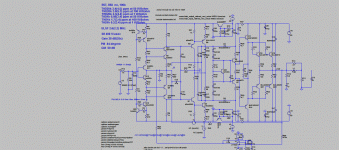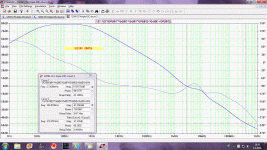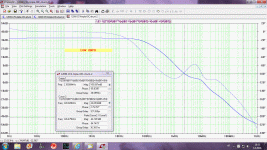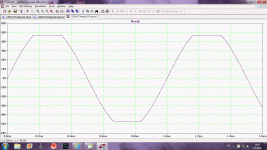Could it just be bad RCA type of connectors which are notorious for hums and buzzes? I'm not saying just cheap interconnects, but just RCA type connectors in general and the way they are terminated?
It always seems that most balanced XLR type of equipment is designed with better thought that goes into the different gain stages as there are better standards at least in professional equipment, could this have much to do with the preference to balanced connections? I can say that there are still ground loop noises even in pro equipment, multiple series connections between multiple pieces of equipment have lots of ways to bring in ground loops through the ac power connections, that is always something that you had to fight in portable PA situations.
It always seems that most balanced XLR type of equipment is designed with better thought that goes into the different gain stages as there are better standards at least in professional equipment, could this have much to do with the preference to balanced connections? I can say that there are still ground loop noises even in pro equipment, multiple series connections between multiple pieces of equipment have lots of ways to bring in ground loops through the ac power connections, that is always something that you had to fight in portable PA situations.
Last edited:
That is classified information. I can disclose, though: it uses some parts with heavily copper plated ferrous leads.
Ok... so its a VFA. Doesnt count here. Too bad on the ferrous metal use.... it is cheaper though. See any 8th? If you do, the plating isnt thick enough.
THx-RNMarsh
Ok... so its a VFA. Doesnt count here. Too bad on the ferrous metal use.... it is cheaper though. See any 8th? If you do, the plating isnt thick enough.
- Sorry, it's not a VFA (at least as defined herein).
- Sorry, it's not a CFA (at least as defined herein).
- The 8th (or in general the n-th) harmonic has nothing to do with the copper plating over ferrous materials.
- The whole amp BOM was well under a ton. Sorry, no boutique parts will ever be used here. For those looking for a business opportunity in the high end audio I would indeed recommend parts with non magnetic leads, silver wire blessed by Tibetan monks, boutique capacitors, Bybee devices, Shakti stones, [insert your favorite audio fetish here], and advertise everything accordingly (and don't forget to add a five figure price tag). You may eventually find an idiot with deep pockets to buy the bollocks.
See any 8th? If you do, the plating isnt thick enough.
THx-RNMarsh
And you have verifiable scientific evidence of this? 🙂
Very nice gain stage PCB Waly, although IMHO 50 kHz square waves should have more harmonics.
Input low pass filter is on. What you see in the Tek scope WaveStar capture are actually the rise/fall times. That is, if I would further increase the square wave level, the rise/fall times will remain constant, and the apparent slew rate will increase. The other way around, if I would decrease the square wave level, the apparent slew rate would decrease.
The rise/fall times have no relationship with the slew rate (hence also no relationship to the known slewing distortion mechanism), they are related to the amplifier bandwidth only. Here, the 3dB bandwidth is ~250KHz (again, defined by the input low pass filter), with less than 0.05dB error in the 20Hz-20KHz audio bandwidth (0.1dB bandwidth is around 30KHz).
Intrinsic/true slew rate is hard to determine, since the output zobel cell R/C (10ohm/25W and a 0.1uF/400V self healing mylar dielectric) explodes at any significant output level of 200KHz square wave, where the slewing is visible.
Waly, that sounds wonderful.
Why don't you put your VFA design up on the VFA thread I opened up a few months ago and we can discuss it there?
Why don't you put your VFA design up on the VFA thread I opened up a few months ago and we can discuss it there?
"Ok... so its a VFA. Doesnt count here. Too bad on the ferrous metal use.... it is cheaper though. See any 8th? If you do, the plating isnt thick enough. "
How can I model this?
😀
How can I model this?
😀
Why don't you put your VFA design up on the VFA thread I opened up a few months ago and we can discuss it there?
Because it's not a VFA, according to the definition herein. Doesn't have diff pairs at the input.
It's also not a CFA, according to the definition herein. Doesn't have "current on demand". It's in this thread only because it has a rather high slew rate.
P.S.1. Also doesn't fit all of your (irrelevant, anyway) CFA criteria.
P.S.2. The big money spender would start up from this prototype level: case, transformer, decent heat sinks (rather than a slab of aluminum), power supply, protections, soft start, etc... Not something that I can or want to pursue. After all, I have no need of such an amp, 50W/channel (I have a small NAD) is doing just fine for me.
Last edited:
I did not and do not claim any CFA 'criteria'. I simply wrote down 4 things to help people identify whether a circuit was VFA or CFA since outside of the gain derivations, in my view the existing material out there was not explicit enough.
CFA vs. VFA Amplifiers: a Short Primer
I am quite happy that they work as intended and stand by them.
If your topology does not fit, it must be something quite unique - please open a thread and post it up. Its no good claiming all sorts of performance characteristics on the forum unless you are prepared to be open and accept some peer feedback. Who knows, you may be the progenator of entirely new class of amplifier.
There are VFA's with very high slew rates (100's of V/us) as well. Take a look at some of OS' designs. Bob Cordell's c. 1980 amp did >300 V/us.
CFA vs. VFA Amplifiers: a Short Primer
I am quite happy that they work as intended and stand by them.
If your topology does not fit, it must be something quite unique - please open a thread and post it up. Its no good claiming all sorts of performance characteristics on the forum unless you are prepared to be open and accept some peer feedback. Who knows, you may be the progenator of entirely new class of amplifier.
There are VFA's with very high slew rates (100's of V/us) as well. Take a look at some of OS' designs. Bob Cordell's c. 1980 amp did >300 V/us.
- Sorry, it's not a VFA (at least as defined herein).
- Sorry, it's not a CFA (at least as defined herein).
Now we are getting closer to what it is..... Compli push-pull is my guess.
But that doesnt matter. Good results are good results. Congrates.... pure gold wire and buss-bars or not. 🙂 And, you havent even hogged out a chassis from a solid block of Teflon, either.
xoxoxo
--- Back to the CFA subject. The CFA's here are all great designs IMO and we all learned a lot about what a CFA is and how to make them work as well as VFA. Now we need more listening to them and some higher powered ones would be more universally useful.
I am curious about the CFA vs VFA shoot out and if there developes a consensus or not about that, listening-wise. As they seem to have with existing CFA designs by leading mfr.
Since they all SIM and should measure well..... is there a characteristic sound of each?
THx-RNMarsh
Last edited:
I have been listening to a stereo CFA design by Marantz (MM7025). 150W'er for a couple weeks now. I got back my VFA design from repair (aint I lazy?) - all the output devices were gone... what a PITA to fix. Tomorrow i will listen to it and compare.... but that Marantz had some very nice qualities. Very much as I have read about it and CFA's. I replaced the input opamp to a 1489 and the opamp I/O coupling caps to larger values and from electros to bipolar and rebiased amp. Thats about all you can do that easy and makes any difference.
Later-
Richard
Later-
Richard
Last edited:
My first design CFA amp is FAILED! 😡
It is not as good as my VSSA variant that has sound "airy:.
After several modification and intensive learn using sim, I was able to make my CFA sound "airy" like my VSSA variant.


My VFA that using same VAS and OPS as my CFA, not as good as my CFA.
I do not know if I can make my VFA as good as my CFA. I will try.....
It is not as good as my VSSA variant that has sound "airy:.
After several modification and intensive learn using sim, I was able to make my CFA sound "airy" like my VSSA variant.



My VFA that using same VAS and OPS as my CFA, not as good as my CFA.
I do not know if I can make my VFA as good as my CFA. I will try.....
120W CFA-tripleOPS
This is my CFA amp with BJT EF3 (triple) output with the power of 130 W/8ohm. It uses combination of shunt compensation and OIC. According to the simulation it should be very stable with quite low distortion. Overload clipping is very good, result of Backer clamp. It is easy to boost the power by increasing number of output transistors and power supply voltage. There is a jumper to choose between high and low global NFB. Distortion is quite consistent over whole output power and frequency range. My intention is to build this simple amp and if it works as expected, to add a cap multiplier for output stage too, with all needed protection on the same board, progressive delayed current fuse, excess DC offset at the loudspeaker and complete power down if one polarity is down.
BR Damir
This is my CFA amp with BJT EF3 (triple) output with the power of 130 W/8ohm. It uses combination of shunt compensation and OIC. According to the simulation it should be very stable with quite low distortion. Overload clipping is very good, result of Backer clamp. It is easy to boost the power by increasing number of output transistors and power supply voltage. There is a jumper to choose between high and low global NFB. Distortion is quite consistent over whole output power and frequency range. My intention is to build this simple amp and if it works as expected, to add a cap multiplier for output stage too, with all needed protection on the same board, progressive delayed current fuse, excess DC offset at the loudspeaker and complete power down if one polarity is down.
BR Damir
Attachments
I am totally in favour of NO global feedback. BUt I would also like Low output impedance and low(ish) distortion and distortion distribution..
As discussed in my book, good amplifiers are achievable without GNFB. There is a distinction worth noting. Some no-feedback advocates mean no NFB loops at all, even if they are not global. These folks tend to have NFB only in the form of emitter degeneration. These are more of a challenge.
No GNFB is a more intelligent middle ground. It allows feedback of the stages prior to the output stage, achieving stable, well-defined forward gain (e.g., 20-30) without necessarily putting a heavy resistive load on the VAS. This will also often offer a lower impedance drive for the output stage, which will be operating without feedback.
To get low output impedance and low distortion from the output stage, you will generally go for more output pairs than you might have in an NFB amp. This allows you to get lower crossover distortion and lower output impedance as a result of the paralleling effect. This also allows you to get a larger class A region without moving into too much gm doubling distortion.
Using more output pairs to achieve lower distortion and lower output impedance also means that your output stage as a whole has more SOA, so less aggressive protection circuits can be used.
Clearly, of course, these techniques can be used to benefit an amplifier with global feedback.
Cheers,
Bob
My first design CFA amp is FAILED! 😡
It is not as good as my VSSA variant that has sound "airy:.
After several modification and intensive learn using sim, I was able to make my CFA sound "airy" like my VSSA variant.
My VFA that using same VAS and OPS as my CFA, not as good as my CFA.
I do not know if I can make my VFA as good as my CFA. I will try.....
😎🙂
This issue of Electronic Design - white paper reprint from Dec 19,1991 by Bob Pease Titled:
"What's All This PSRR vs Frequency Stuff Anyhow?"
Thx-RNMarsh
"What's All This PSRR vs Frequency Stuff Anyhow?"
Thx-RNMarsh
DC servo capacitor
Hello Richard,
This ia question for you, without trying to be provocative (sound of caps) what capacitor do you like to use for the DC servo in a CFA power amplifier of for that matter VFA amplifier. Or are you into designing them out.
Regards
Arthur
Hello Richard,
This ia question for you, without trying to be provocative (sound of caps) what capacitor do you like to use for the DC servo in a CFA power amplifier of for that matter VFA amplifier. Or are you into designing them out.
Regards
Arthur
Of course, I would design them out when possible. With a line stage (low gain) circuits it is possible to not use them and still be direct coupled. With high gain, it is really hard. With power amps and their large thermal change potential it is a mixed bag - they are not high gain circuits but the temp can vary a lot without very large heat sinks.
I dont think it matters a lot when the servo only sees dc drift/offset. But generally, PP are not expensive, easy to find and work very well. It is more important in a servo to get the CMR and DMR dealt with in a 2 stage servo, perhaps. As John Curl has pointed out to me, recently.
Thx-RNMarsh
I dont think it matters a lot when the servo only sees dc drift/offset. But generally, PP are not expensive, easy to find and work very well. It is more important in a servo to get the CMR and DMR dealt with in a 2 stage servo, perhaps. As John Curl has pointed out to me, recently.
Thx-RNMarsh
- Home
- Amplifiers
- Solid State
- CFA Topology Audio Amplifiers



